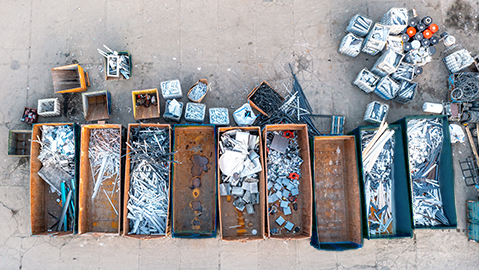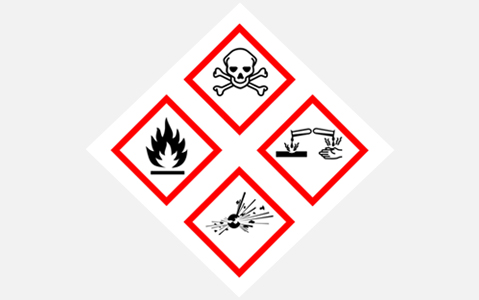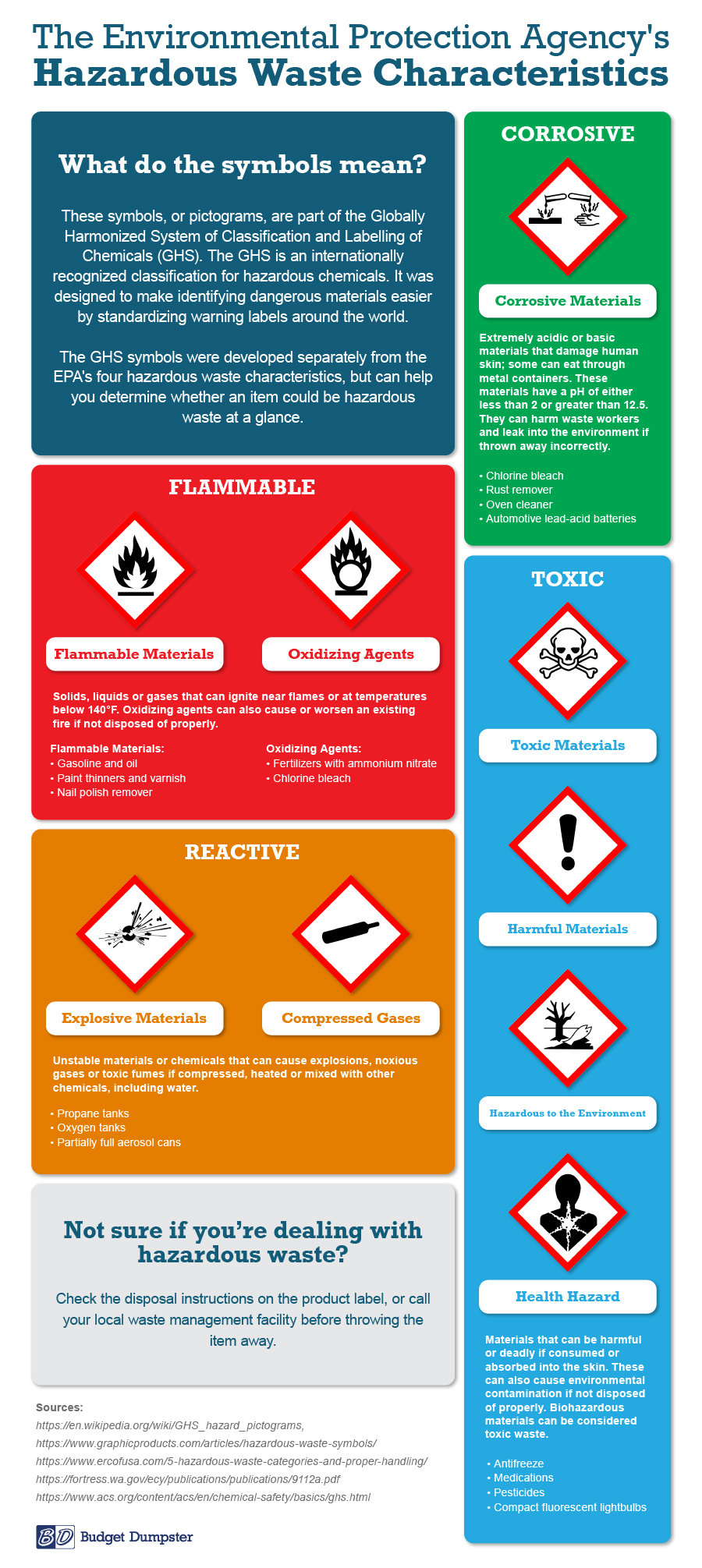
Hazardous Waste Disposal

What Is Hazardous Waste?
Hazardous waste is any material that can be unsafe to humans or the environment if thrown out improperly. While certain items may be safe when used correctly in your home, throwing hazardous waste items in a dumpster can pose serious risks — and may result in extra disposal fees. Federal law also prohibits household trash services from picking up hazardous waste with regular collection.
If you come across hazardous waste while cleaning up at home or on a jobsite, it’s important to know how to dispose of it since it cannot be handled like other trash. Use this guide to learn about the types of hazardous waste and how to get rid of them.
Why Can’t You Throw Hazardous Waste in a Roll Off Dumpster?
Hazardous items aren’t allowed in dumpsters for safety reasons. Hazardous waste can cause fires, dangerous chemical reactions, explosions, environmental contamination and more during the normal disposal process.
When a dumpster arrives at a landfill, the debris it contains gets sorted. The landfill will charge a disposal fee if it finds hazardous waste. This is because hazardous waste needs extra treatment and only a designated waste facility can process it.

What Is Considered Hazardous Waste?
The Environmental Protection Agency (EPA) categorizes hazardous waste into three main types: listed, mixed radiological and characteristic wastes:
-
Listed wastes are from specialized manufacturing processes. This includes solvents, sludges and wastewaters from petroleum refining or pesticide production.
-
Mixed radiological wastes contain hazardous and radioactive waste. Handling mixed waste is a complex process that usually requires removing one of the hazards.
-
Characteristic wastes are the most common types of hazardous waste. They can be found in almost every home. There are four hazardous waste categories classified under characteristic. Each of these has an international GHS Hazard Symbol for easy identification.

What Is a GHS Hazard Symbol?
Globally Harmonized System of Classification and Labeling of Chemicals (GHS) symbols are used on labels to alert consumers to various physical, health and environmental hazards associated with certain products.
Hazardous Waste Categories
Flammable Hazardous Waste
Flammable, or ignitable, wastes can easily catch fire if tossed in the regular trash. This can rapidly worsen an existing fire or cause one to start. Flammable hazardous waste can be in solid, liquid or gaseous form.
Oxidizing agents, or oxidizers, are chemicals that give off oxygen when they come in contact with other substances. Oxidizers can intensify an existing fire and dangerously react with other chemicals. Some oxidizers, like hydrogen peroxide, are safe to dispose of normally, while others, such as pool chemicals and fertilizers, are not.
Examples of Flammable Hazardous Waste
• Nail polish remover (acetone)
• Rubbing alcohol (isopropyl alcohol)
• Diesel fuel, motor oil and kerosene
• Cleaning solvents
• Matches and flares
Corrosive Hazardous Waste
Corrosive wastes are extremely acidic or basic materials that can damage human skin. Some are strong enough to erode metal, steel drums and dumpsters. These wastes can also contaminate groundwater and harm aquatic life in the surrounding area if thrown out improperly.
Examples of Corrosive Hazardous Waste
• Chlorine bleach
• Rust remover
• Oven cleaner
• Automotive lead-acid batteries
Reactive Hazardous Waste
Reactive wastes are unstable and may readily explode, even under normal pressure or temperatures. Some also release toxic gases when exposed to other common chemicals.
Compressed gases, including unemptied aerosol cans, run the risk of exploding in the heat of a landfill or in a garbage truck compressor.
Examples of Reactive Hazardous Waste
• Fertilizer (ammonium nitrate)
• Propane and oxygen tanks
• Partially filled aerosol cans
• Ammunition
Toxic Hazardous Waste
Toxic wastes can be harmful — even deadly — if consumed or absorbed into the skin. Some toxic wastes can cause severe eye or skin irritation, respiratory issues and environmental contamination if not disposed of properly, which can impact the local ecosystem and watershed.
Biohazardous waste can also be considered toxic. This includes used needles and contaminated personal protective equipment.
Examples of Toxic Hazardous Waste
• P, U, and D-Listed Medications
• Antifreeze
• Pesticides
• Compact fluorescent lightbulbs
How to Identify Hazardous Waste

How to Dispose of Hazardous Waste
From batteries to bathroom cleaners, each type of hazardous waste has a different procedure for proper disposal. Here are disposal methods for some common hazardous materials.
![]()
How to Dispose of CFLs
Compact fluorescent lamps (CFLs), also known as compact fluorescent lights, contain mercury, which can leak into the environment if not disposed of properly. Several waste collection agencies, retailers and mail-in programs offer CFL recycling.
![]()
How to Dispose of Pool Chemicals
If you can’t use up chlorine and other swimming pool products, consider donating them to a fellow pool owner. Otherwise, take your old pool chemicals to a local household hazardous waste facility.
![]()
How to Dispose of Fireworks
Soak flares and fireworks overnight in water. Next, securely double-bag them so they don’t dry out. Then, you can throw them in the trash normally.
![]()
How to Dispose of Matches
Matches should be soaked in a bowl of water for a few minutes before being thrown away. You can also use them up in your fireplace or fire pit.
![]()
How to Dispose of Old Paint
Many varnishes, polishes, waxes and oil-based paints contain solvents that are extremely flammable. The best way to dispose of oil-based paints and other leftover household solvents is to take them to a household hazardous waste collection program or facility.
![]()
How to Dispose of Asbestos
If you’re updating a home that was built before 1980, you may run into asbestos at some point during your project. The removal and disposal process can be expensive and hazardous to your health and others’ if done improperly, so make sure to call an expert.
![]()
How to Dispose of Bleach and Rubbing Alcohol
Bleach and many other cleaners are made up of strong acids that can be corrosive and harmful to human skin. If you have fewer than five gallons of bleach, it can be flushed down a toilet with no other chemicals. You can recycle the container, but rinse it out with water and replace the cap.
If you have a septic system, it’s best to minimize your use and disposal of bleach and ammonia. Both chemicals can react inside your septic tank to create chlorinated hydrocarbons, which can be a health hazard. If you can’t use up your bleach, take it to a hazardous waste facility.
![]()
How to Dispose of Aerosols
Aerosol cans are allowed to be thrown in a trash can or dumpster once they’ve been completely emptied. However, unemptied aerosol cans could explode if compressed. Do not spray aerosols into the air to empty them — try to use them up if possible.
If you’re dealing with an expired aerosol that contains harsh chemicals, such as old spray paint or oven cleaner, take the cans to a hazardous waste facility.
![]()
How to Dispose of Pesticides
Pesticides, weedkillers and other landscaping chemicals are toxic and should be handled and disposed of as directed on their containers. When in doubt, most can be taken to a local hazardous waste facility, as long as the chemical was produced for residential, not commercial, use.
![]()
How to Dispose of Ammunition
Bullets and other ammunition should never be thrown away in the usual trash, as they can be ignited when the garbage compactor runs, which can send the bullets flying.
You may be able to take old ammunition to your local police department or fire station, but call their non-emergency line ahead of time to confirm. A local gun range may also be able to help you dispose of unwanted bullets.
![]()
How to Dispose of Batteries
Single use batteries made of common metals can be disposed of in your regular trash in all states except for California. Check with your local waste district or mail-in programs for recycling options.
Automotive batteries contain lead-acid cells that are extremely corrosive. Recycle car batteries at an appropriate metal recycling facility or auto retailer.
Rechargeable batteries from laptops and other electronics can catch fire or leak toxic and corrosive chemicals if compressed. Some states such as California, New York and Illinois have banned electronics and batteries from going in landfills. Learn more about regulations in your area before throwing them in the trash. You can often trade-in or recycle your electronic batteries.
![]()
How to Dispose of Railroad Ties
Railroad ties are treated with the toxic preservative creosote and can be difficult to dispose of. They are not accepted in roll off dumpsters. According to the EPA, you may be able to dispose of creosote-treated wood with your usual trash pickup, but local governments may have specific guidelines or instructions.
Check with your state or city waste management program before disposing of railroad ties. Because railroad ties are considered commercial waste, they might not be accepted at your local hazardous waste facility.
When handling and disposing of railroad ties, use gloves, goggles and other protective clothing to prevent direct contact. Wash all work clothes in a separate load of laundry immediately after handling railroad ties. Never burn creosote-treated wood. Burning it may release toxic chemicals.
![]()
How to Dispose of Nail Polish Remover
Nail polish remover contains acetone, which is considered flammable hazardous waste. Dumping it down the sink can cause damage to your pipes and contamination to waterways.
To dispose of small amounts of nail polish remover, soak up the remaining acetone with cotton balls. As long as you place a separate plastic bag over the acetone, you can dispose of it with the rest of your garbage. Take large amounts of acetone to a hazardous waste facility.
![]()
How to Dispose of Diesel Fuel and Motor Oil
Diesel fuel, motor oil and kerosene are extremely flammable. Take these lubricants to a hazardous waste facility or collection event. Your local auto shop may also accept used motor oil.
Make sure the fuel is securely stored in its original container or a gas can before transporting it to an appropriate disposal facility.
Frequently Asked Questions About Hazardous Waste
What is household hazardous waste?
Household hazardous waste, sometimes abbreviated as HHW, is flammable, corrosive, reactive or toxic waste that, as its name suggests, can be found around the house.
Examples of household hazardous waste include:
- Paint
- Pesticides
- Fuels
- Solvents
Where can I take hazardous waste?
Hazardous waste can never be disposed of in a dumpster or curbside trash pickup. This type of waste can be taken to a local household hazardous waste facility instead. However, certain items, including products and chemicals manufactured for commercial use, may not be accepted.
Some communities have an annual hazardous waste collection event. Give your local solid waste district a call to find out what to do with your hazardous items.
What is inert waste?
While tires are not always hazardous waste, they can burn for long periods of time if ignited and trap methane gas within them. Most landfills do not accept them, which means you cannot throw them in a dumpster. Contact your local community waste facility to learn how to dispose of tires.
Which appliances are considered hazardous waste?
Appliances with refrigerants are considered hazardous. In some areas, you can dispose of these items in a dumpster if you drain liquids first. Older model electric appliances may also be considered hazardous waste due to toxic mercury switches.
Reach out to us if you have an appliance you’re trying to dispose of. We’ll let you know if it is accepted. If not, contact your local household hazardous waste collection center.
Examples of hazardous appliances include:
- Refrigerators
- Freezers
- Window AC units
- Space heaters
- Gas-fired appliances
Is electronic waste considered hazardous?
E-waste can be hazardous due to certain components within the electronics. This includes computers, phones, TVs and even microwaves.
Each community has different guidelines for handling e-waste. In some areas, you can dispose of electronics in your normal trash or in a dumpster. In others, you may have to take your e-waste to a dedicated recycling facility.
Still have questions about hazardous waste disposal?
If you’re renting a dumpster and need to know if your debris is allowed, our waste removal experts can answer your questions. Depending on where you live, certain materials might not be allowed in a dumpster even if they’re not hazardous. Get in touch with us today to ask about specific items.